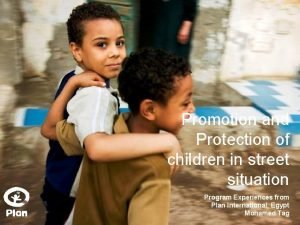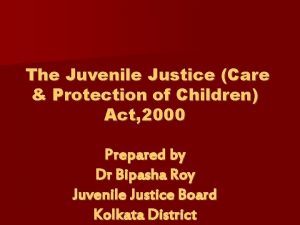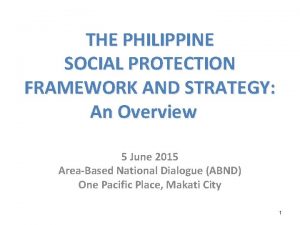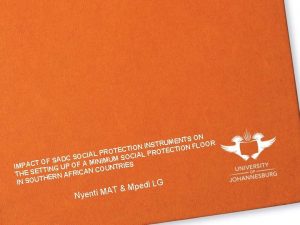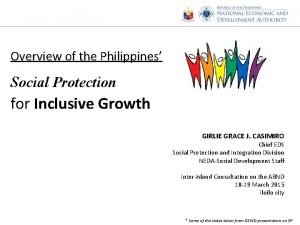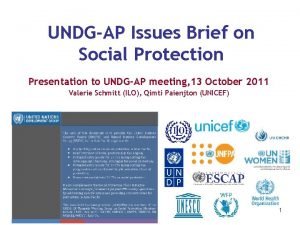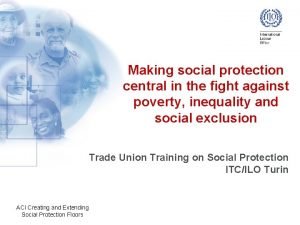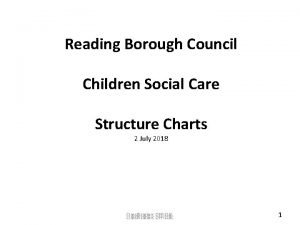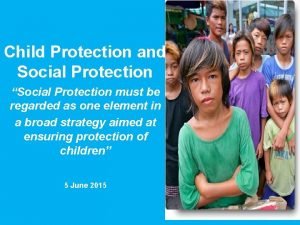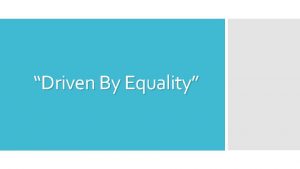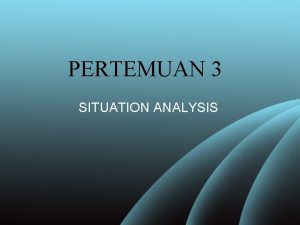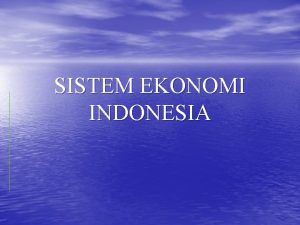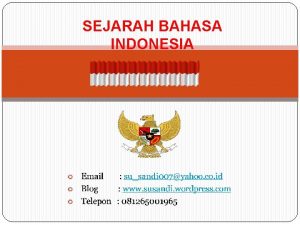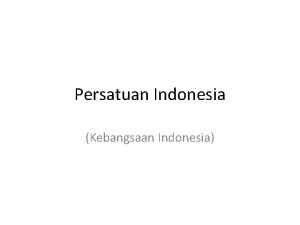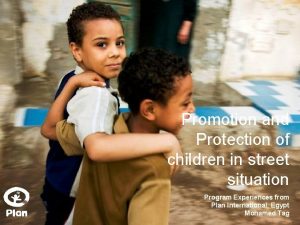SOCIAL PROTECTION FOR CHILDREN IN INDONESIA Situation Analysis



















- Slides: 19

SOCIAL PROTECTION FOR CHILDREN IN INDONESIA: Situation Analysis Edi Suharto, Ph. D Bandung College of Social Welfare, Indonesia Website: www. policy. hu/suharto Email: suharto@policy. hu Expert Meeting, Social Security and Social Protection Floor (SPF), ILO Jakarta 13 December 2011

Menu v Social protection: the concept and context v Situation of children in Indonesia v Social protection for children: the case of Conditional Cash Transfer of PKSA

The concept • Social protection is a term sometimes used interchangeably in the literature with social service, social assistance or social security. • Generally, it is about people and families having security in the face of vulnerabilities and contingencies (eg. having access to health care or working in safety). • It may consist of five elements: labour market, social assistance, social insurance, area or communitybased initiatives, child protection (ADB, 2005)

Global context • Social protection regimes vary across regions, but there are commonalities • Children are more vulnerable than adults, especially those living in difficult situations • Social protection schemes for children are far less developed than for adults and elderly • Social protection can be provided by developed as well as less developed countries: at least between 1 and 5% of GDP

Public expediture for social security in selected countries (% of GDP, 2009) Source: Nishino, Yoshimi dan Gabriele Koehler (2011: 21 -22)

Social Security Statutory provision Country Overall Coverage 1 2 3 4 5 Lao PDR Limited Philippines Limited Bangladesh V. Limited Indonesia V. Limited 7 Cambodia n. a. India Semi Compsive Thailand 8 n. a. Compsive Vietnam Semi Compsive China Semi Compsive Limited Singapore 6 n. a. Notes: 1) Sickness 2) Maternity 3) Old Age 4) Invalid 5) Survivor 6) Family Allowance 7) Injury 8) Unemployment Source: Nishino, Yoshimi dan Gabriele Koehler (2011: 21 -22)

Children in Indonesia • The Law No. 23/2002 on Child Protection: child is “every human being under the age of 18, including those still in the womb. ” • The number of children is about 30% of the total population: 85 million children • Many Indonesian children are in vulnerable situations Source: AIPA Caucus Report (2011)

Situation of children (1) Courtesy of UNESCAP • Each year, about 4 -5 million babies are born, aggravated with high infant mortality rate, which is 34/100 birth • About 60 per cent of children under five years old do not have birth certificates; about half are not registered anywhere. • Three million children work in potentially hazardous occupations. • Around 12 per cent of females are married at or before the age of 15. • At least 30 per cent of all female sex workers in Indonesia are under eighteen years of age, with children as young as ten are forced into prostitution. • An estimated 100, 000 women and children are trafficked annually, mostly as commercial sex workers in Indonesia and abroad. Source: UNICEF (2011), AIPA Caucus Report (2011)

Situation of children (2) • Special vulnerability of children and women in conflict- or disaster-affected communities, including more than 2, 000 children left parentless and many more psychologically affected after the tsunami that struck Aceh and North Sumatra on December 26, 2004. • There about 7, 000 institutions for children that care for over 127, 000 children who are parentless, neglected, or whose parents cannot provide adequately for them. • Some 4, 000 to 5, 000 children are in detention centers, correction facilities and prisons; 84 percent of those sentenced are detained with adult criminals. Source: UNICEF (2011), AIPA Caucus Report (2011)

Social Protection in Indonesia • Social protection has been gaining importance in Indonesia, especially after the financial crisis hit the country in 1997. Poverty Reduction Strategies: Three Clusters Credit schemes for micro and small-scale enterprise • The initiative to strengthen Community social protection systems is empowerment paramount within the context program for the poor of poverty reduction Social strategies. assistance/protection for the poorest

Law on Social Protection • The 1945 Constitution places high emphasis on social protection. Sub-section 2 of Article 34 states that the state shall develop a social security system for all citizens. • Law No 40, 2004 about National Social Security System (SJSN): social protection includes pension and old-age benefits; health benefits; employment accident benefits; and death benefits • Law No 11, 2009 about Social Welfare: every citizens should have their minimum life needs and social services through social rehabilitation, social security, social protection and social empowerment.

Social Protection: general • Subsidies for fuel, mainly kerosene; subsidized rice (RASKIN/Rice for the Poor); cooking oil; agricultural sector: fertilizer and seed • Employment Generation (Padat Karya Program) to provide income support for the unemployed and the poor • Health Card program for the poor (Askeskin – Jamkesmas) • Unconditional Cash Transfer: BLT for the poor and vulnerable (eg. neglected elderly, persons with disabilities Sumarto and Bazzi (2011); Suharto (2009)

Social protection: children • Scholarships for students from poor families • School Operational Assistance (BOS): part of government policy to achieve nine years of compulsory education, focusing on primary and secondary schools (SD & SMP) receiving Rp 235, 000 and Rp 324, 000 per students • Conditional Cash Transfer (PKH/Family Hope Program) • Social Welfare Program for Children (PKSA)

The case of PKSA v Implementing agency: Ministry of Social Affairs in collaboration with Post Offices; involving LKSA (social welfare institutions for children) and facilitators (Sakti Peksos, community social workers) v PKSA = CCT targeted for vulnerable children: § § § Neglected babies under five years of age Neglected children/street children Children with disabilities Children in conflict with the law Children in needs of special protection

Conditions/requirements • Positive changes in attitutes and behaviour (social functioning) of beneficiaries • Frequency of attendance or participation in obtaining basic social services provided by respective agencies • Increased responsibility of parent or family in child care and protection • Improved roles and performances of LKSA (social welfare insitutions for children)

Advantages • Supplementing PKH: covering various types of vulnerable children, including children in needs of social protection outside PKH beneficiaries (eg. children/families with no “identity”) • Providing social assistance/subsidy for basic needs (Rp 1. 5 million per year/ per child) • Improving accessibility of children to basic social needs (eg. birth certificate, education, health, shelter and clean water, recreation, skills, etc. ) • Empowering parent’s or family’s responsibility in child care and protection • Strengthening community participation in child protection through the involvement of LKSA (social welfare institutions for children)

Challenges • Target: 230, 000 children • Limited coverage: 2009 pilot projects in 5 provinces (Jakarta, West Java, Yogyakarta, South Sulawesi, Lampung); 2011 plus Aceh and NTT covering 16, 405 children • Inclusion and exclusion errors (heavily rely on data from Dinsos and LKSA; only West Java having data, by name by address, done by Dinsos in 14 districts/cities) • Limited effectiveness: slow changes of attitude and behaviour of targeted beneficiaries • More complex than PKH, not easy to measure accountability and needs skilled facilitators • Lack of standardized M&E instruments • Lack of, and uncertain future budget Source: interviews with PKSA Task Force (2011)

Lessons learned • Indonesia needs to have “permanent” social protection for children. PKH and PKSA can serve as models and best practices that can be developed to become national policies • As elsewhere, inclusion and exclusion errors remain the issues in targetted poverty reduction innitiatives. Updated data base needs to cover key socioeconomic status of families/households and children, by name and by address • Since the framework often involve a number of sectors/actors, the improvement of coordination and quality of related social service providers is important • Monitoring and evaluation needs to be conducted regularly by independent research/policy institutes

EDI SUHARTO AT A GLANCE The background • Specialist in the area of Social Work Macro Practice: social policy, social protection, child protection, CSR, community development • Education: Bandung College of Social Welfare (BSW); Asian Institute of Technology, Thailand (MSc), Massey University, New Zealand (Ph. D) • Present positions: Vice Chairperson for Academic Affairs, Bandung College of Social Welfare and Lecturer (S 1, S 2, S 3): Padjadjaran Univ. Bandung; Pasundan Univ. Bandung, Bogor Institute of Agriculture, Islamic State Univ. Yogyakarta; Univ. of Indonesia, Jakarta • Policy Fellow/Analyst and consultant: Kemenko Kesra; Centre for Policy Studies (CPS), Hungary; Local Governance Initiative (LGI), Hungary; Galway Development Services International (GDSI), Ireland; Plan International Indonesia; UNICEF, Equitas (International Human Rights Organization), Canada, Pro. Rep USAID Some publications • CSR dan Comdev, Bandung: Alfabeta (2011) • Profiles and Dynamics of the Urban Informal Sector in Indonesia , Saarbrucken, Germany: Lambert Academic Publishing (2010) • “Opportunities and Challenges of Taxing the Urban Informal Economy” in Nick Devas (ed), Local Government and Local Taxation of the Informal Economies, Budapest: Open Society Institute (2011) • “Social Protection Systems in ASEAN: Social Policy in A Comparative Analysis”, Social Development Issues, Vol. 31, No. 1 (2009) • Kemiskinan dan Perlindungan Sosial di Indonesia , Bandung: Alfabeta (2009) • Kebijakan Sosial Sebagai Kebijakan Publik, Bandung: Alfabeta (2 nd ed. 2008) • Pekerjaan Sosial di Dunia Industri: Memperkuat CSR , Bandung: Refika Aditama (2007) • Analisis Kebijakan Publik, Bandung: Alfabeta (4 th ed. 2008); • Membangun Masyarakat Memberdayakan Rakyat, Bandung: Refika Aditama (2 nd ed. 2006) • “How Informal Enterprises Coped with the Asian Economic Crisis: The Case of Pedagang Kakilima in Bandung” in Edwina Palmer (ed), Asian Futures, Asian Traditions, London: Global Oriental (2005) • "Human Development and the Urban Informal Sector in Bandung, Indonesia: the Poverty Issue, “ New Zealand Journal of Asian Studies (NZJAS), Vol. 4, No. 2. , 2002 • Pembangunan, Kebijakan Sosial dan Pekerjaan Sosial , Bandung: Lembaga Studi Pembangunan (1997)
 Children in street situation
Children in street situation Cncp and ccl
Cncp and ccl Indonesia tanah air beta pusaka abadi nan jaya
Indonesia tanah air beta pusaka abadi nan jaya Apa itu social thinking
Apa itu social thinking Social thinking social influence social relations
Social thinking social influence social relations Social protection operational framework philippines
Social protection operational framework philippines Social protection instruments
Social protection instruments Social protection operational framework philippines
Social protection operational framework philippines Social protection
Social protection Handling information in care settings
Handling information in care settings Ilo social protection
Ilo social protection Reading borough council children's social services
Reading borough council children's social services Fspos vägledning för kontinuitetshantering
Fspos vägledning för kontinuitetshantering Typiska drag för en novell
Typiska drag för en novell Tack för att ni lyssnade bild
Tack för att ni lyssnade bild Vad står k.r.å.k.a.n för
Vad står k.r.å.k.a.n för Varför kallas perioden 1918-1939 för mellankrigstiden
Varför kallas perioden 1918-1939 för mellankrigstiden En lathund för arbete med kontinuitetshantering
En lathund för arbete med kontinuitetshantering Underlag för särskild löneskatt på pensionskostnader
Underlag för särskild löneskatt på pensionskostnader Personlig tidbok
Personlig tidbok
